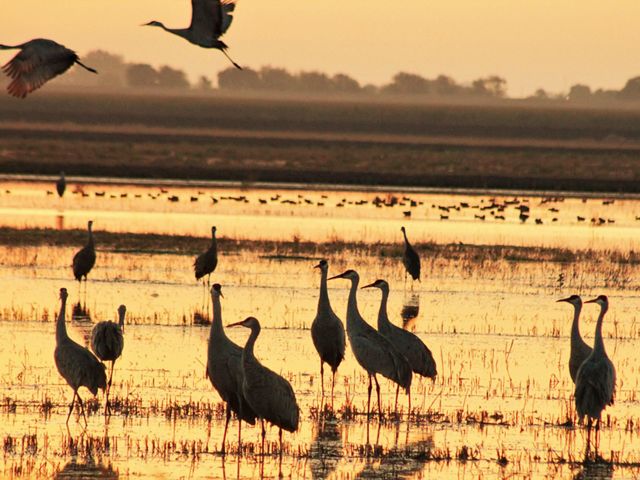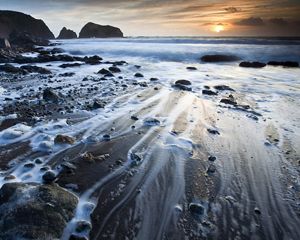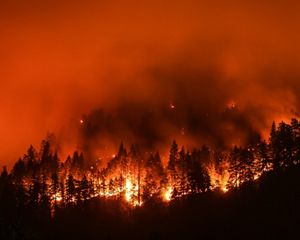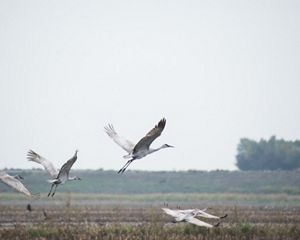Staten Island
California

Staten Island is an extraordinary example of wildlife-friendly farming that represents a unique opportunity for conservation.
18 Years of Conservation
Located in the heart of the Sacramento-San Joaquin River Delta, Staten is 9,200 acres located between the North and South Forks of the Mokelumne River.
Staten Island has been a wintering destination for sandhill cranes moving along the Pacific Flyway for more than 40 years. In cooperation with our partners, TNC acquired the island in 2001 to protect its important role as a place for wildlife-friendly agriculture to support conservation along the flyway.
TNC’s acquisition of Staten Island represented an unprecedented commitment to protect important migratory bird habitat from the growing threat of development in the Delta while continuing to operate it as a working farm.
The purchase was funded by grants from the California Department of Water Resources and the California Natural Resources Agency, through the joint state and federally funded CALFED Bay-Delta Program among the Natural Resources Agency, CALFED and the National Fish and Wildlife Foundation.
Under TNC’s ownership, Staten Island has become a:
- critical wintering ground in the Delta essential for sandhill cranes and a host of other migratory birds;
- demonstration of how wildlife-friendly farming can be an economically viable option for farmers; and
- living laboratory for science-based approaches to habitat creation in the face of drought, climate change and land conversion.
Investing in Farms and Wildlife
TNC has invested more than $27 million in land protection, new science and partnerships at Staten Island and in the Delta to benefit migratory birds and the community.
Conservation Significance
Significant losses of small-grain crops (cranes’ preferred foraging habitat) in the Delta region due to development and conversion of traditional agricultural land to orchards and vineyards is a continuing challenge. As such, Staten Island provides crucial habitat for cranes.
Sandhill cranes are the primary conservation focus on the Island—15% of all greater sandhill cranes in the Central Valley winter on Staten, and more than half of greater and lesser sandhill cranes in the North Delta winter on Staten.
Staten supports significant numbers of other migratory waterfowl and shorebirds, as well as a variety of wildlife throughout the year.
With thousands of acres of crops in production annually, Staten Island’s assortment of crops provides both foraging and roosting habitat across the fall and winter seasons for wintering cranes. Important crops are corn, triticale, potatoes, alfalfa and irrigated pasture.
Diverse crop management is being used to demonstrate the potential for enhanced foraging habitat for cranes and other wildlife while improving the diversity and viability of the farming operation. Staten Island shows that crops—widely grown in the Delta—can benefit both farmers and birds.
Conservation Investments in the Central Valley
Enhancing wildlife-friendly farming practices and habitat in the larger Delta landscape is essential to maintaining these populations. Since the acquisition of Staten Island, TNC has invested $27 million at Staten Island plus other conservation work in the Delta and the Cosumnes River Preserve to benefit cranes and other migratory waterfowl. Investments include science, habitat protection and restoration, and partnerships.

Critical Bird Habitat
Staten Island provides a winter home for 15% of all greater sandhill cranes in the Central Valley and more than half of greater and lesser sandhill cranes in the North Delta.
Science and Research
- BIRDRETURNS: Combining crowd-sourced data from birdwatchers, scientific research and NASA satellites and by offering economic incentives, TNC is working with Sacramento Valley farmers to flood fields precisely when and where migratory birds need it most. BirdReturns fields account for 60% or more of the total habitat available to shorebirds in Central Valley rice fields.
- AVIAN USE OF AGRICULTURE & DELTA HABITATS: Working with partners, TNC is studying waterbird use of the various crops planted in the Central Valley and of wetlands and crops in the Delta, examining cropping patterns and management practices to meet the needs of waterbirds.
- CRANE POPULATION AND HABITAT RESEARCH: TNC has led and coordinated crane and waterbird research on Staten and in the region. Data is being used to guide conservation and land management strategies.
HABITAT PROTECTION & RESTORATION
The Cosumnes River Preserve provides critical habitat for sandhill cranes and other migratory birds. The preserve is a bird-watchers paradise and is visited annually by tens of thousands. On a given day you can see more birds than people.
In partnership with government and nonprofits, TNC manages thousands of acres of habitat, provides educational opportunities for local schools and is restoring tidal wetlands in the Delta. Investments by TNC have expanded the Cosumnes River Preserve by 3,388 acres since 2002.

RESEARCH PARTNERS
Our partners include the U.S. Fish and Wildlife Service, the U.S. Geological Survey, the California Department of Water Resources, Oregon State University, and the University of California at Davis and Merced.
PARTNERSHIPS
MIGRATORY BIRD CONSERVATION PARTNERSHIP: TNC, Point Blue Conservation Science and Audubon formed a partnership in 2008 to protect and enhance wetland, riverside and agricultural habitat in the Central Valley to sustain migratory bird populations along the Pacific Flyway in the face of land use and climate change.
COMMUNITY ENGAGEMENTS: TNC works with resource agencies and other conservation groups to monitor sandhill cranes, is an active contributor to the Lodi Crane Festival and the Galt Winter Bird Festival and supports visits from Galt school children to the Cosumnes River Preserve for experiential field science programs.
A Path Forward: Meeting the Challenges of Tomorrow
There are continuing challenges ahead for Staten Island and migratory bird conservation in the Delta and Central Valley, including growing threats from water availability, climate change, salt water intrusion, subsidence, crop conversion and development. Migratory birds in California require investments in a mosaic of habitat that will be resilient in response to these challenges.
With its long-standing partners, TNC is advancing cutting-edge science to determine where investments in habitat would best support a viable crane population size in the Pacific Flyway; how much additional habitat is needed to protect this vulnerable species; and how climate change, crop conversion and other changes in the Delta will impact those habitat needs.


